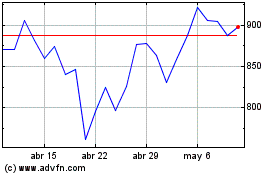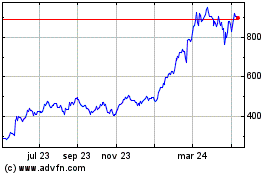NVIDIA Accelerates Google Quantum AI Processor Design With Simulation of Quantum Device Physics
18 Noviembre 2024 - 12:30PM

SC24 -- NVIDIA today announced it is working with Google Quantum AI
to accelerate the design of its next-generation quantum computing
devices using simulations powered by the NVIDIA CUDA-Q™ platform.
Google Quantum AI is using the hybrid quantum-classical
computing platform and the NVIDIA Eos supercomputer to simulate the
physics of its quantum processors. This will help overcome the
current limitations of quantum computing hardware, which can only
run a certain number of quantum operations before computations must
cease, due to what researchers call “noise.”
“The development of commercially useful quantum computers is
only possible if we can scale up quantum hardware while keeping
noise in check,” said Guifre Vidal, research scientist from Google
Quantum AI. “Using NVIDIA accelerated computing, we’re exploring
the noise implications of increasingly larger quantum chip
designs.”
Understanding noise in quantum hardware designs requires complex
dynamical simulations capable of fully capturing how qubits within
a quantum processor interact with their environment.
These simulations have traditionally been prohibitively
computationally expensive to pursue. Using the CUDA-Q platform,
however, Google can employ 1,024 NVIDIA H100 Tensor Core GPUs at
the NVIDIA Eos supercomputer to perform one of the world’s largest
and fastest dynamical simulation of quantum devices — at a fraction
of the cost.
“AI supercomputing power will be helpful to quantum computing’s
success,” said Tim Costa, director of quantum and HPC at NVIDIA.
“Google’s use of the CUDA-Q platform demonstrates the central role
GPU-accelerated simulations have in advancing quantum computing to
help solve real-world problems.”
With CUDA-Q and H100 GPUs, Google can perform fully
comprehensive, realistic simulations of devices containing 40
qubits — the largest-performed simulations of this kind. The
simulation techniques provided by CUDA-Q mean noisy simulations
that would have taken a week can now run in minutes.
The software powering these accelerated dynamic simulations will
be publicly available in the CUDA-Q platform, allowing quantum
hardware engineers to rapidly scale their system designs.
About NVIDIANVIDIA (NASDAQ: NVDA) is the world
leader in accelerated computing.
For further information,
contact:Cliff EdwardsNVIDIA
Corporation+1-415-699-2755cliffe@nvidia.com
Certain statements in this press release including, but not
limited to, statements as to: the benefits, impact, and performance
of NVIDIA’s products, services, and technologies, including NVIDIA
CUDA-Q platform, NVIDIA Eos supercomputer, and NVIDIA H100 Tensor
Core GPUs; Google using our products and technologies, the benefits
and impact thereof, and the features, performance and availability
of its offerings; and AI supercomputing power being helpful to
quantum computing’s success are forward-looking statements that are
subject to risks and uncertainties that could cause results to be
materially different than expectations. Important factors that
could cause actual results to differ materially include: global
economic conditions; our reliance on third parties to manufacture,
assemble, package and test our products; the impact of
technological development and competition; development of new
products and technologies or enhancements to our existing product
and technologies; market acceptance of our products or our
partners' products; design, manufacturing or software defects;
changes in consumer preferences or demands; changes in industry
standards and interfaces; unexpected loss of performance of our
products or technologies when integrated into systems; as well as
other factors detailed from time to time in the most recent reports
NVIDIA files with the Securities and Exchange Commission, or SEC,
including, but not limited to, its annual report on Form 10-K and
quarterly reports on Form 10-Q. Copies of reports filed with the
SEC are posted on the company's website and are available from
NVIDIA without charge. These forward-looking statements are not
guarantees of future performance and speak only as of the date
hereof, and, except as required by law, NVIDIA disclaims any
obligation to update these forward-looking statements to reflect
future events or circumstances.
Many of the products and features described herein remain in
various stages and will be offered on a when-and-if-available
basis. The statements above are not intended to be, and should not
be interpreted as a commitment, promise, or legal obligation, and
the development, release, and timing of any features or
functionalities described for our products is subject to change and
remains at the sole discretion of NVIDIA. NVIDIA will have no
liability for failure to deliver or delay in the delivery of any of
the products, features or functions set forth herein.
© 2024 NVIDIA Corporation. All rights reserved. NVIDIA, the
NVIDIA logo and CUDA-Q are trademarks and/or registered trademarks
of NVIDIA Corporation in the U.S. and other countries. Other
company and product names may be trademarks of the respective
companies with which they are associated. Features, pricing,
availability and specifications are subject to change without
notice.
A photo accompanying this announcement is available at
https://www.globenewswire.com/NewsRoom/AttachmentNg/823fa93b-bab5-4f04-af9a-0812a2f9a41f
NVIDIA (NASDAQ:NVDA)
Gráfica de Acción Histórica
De Dic 2024 a Ene 2025

NVIDIA (NASDAQ:NVDA)
Gráfica de Acción Histórica
De Ene 2024 a Ene 2025
